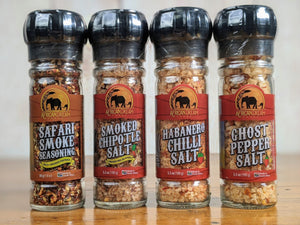Peppers vs. Chilies: Unpacking the Difference
Aug 21, 2024
Peppers and chilies are staples in cuisines around the world, known for their vibrant flavors and varying heat levels. Despite their widespread use, there is often confusion about whether these terms mean the same thing. Let’s delve into the differences and similarities between peppers and chilies, explore various types, and understand their unique characteristics.
Understanding the Terminology
In the world of spicy foods, the terms “pepper” and “chili” are frequently used, sometimes interchangeably. But are they truly the same? The answer lies in their botanical background and regional usage.
- Botanical Background: Both peppers and chilies belong to the genus Capsicum. The term “pepper” is broad, encompassing both spicy and non-spicy varieties. On the other hand, “chili” typically refers to the spicier types. This distinction is crucial in understanding the differences between the two.
- Regional Usage: The use of “pepper” and “chili” can vary significantly by region. In the United States, “pepper” is often used for both sweet and hot varieties, while “chili” specifically denotes spicy types. For instance, a jalapeno, known for its moderate heat, is classified as both a pepper and a chili.
Peppers Around the World
Peppers are cultivated globally, with various types suited to different culinary traditions. Let’s explore some of the common types and their unique features.
- Bell Peppers: Known for their sweet flavor and crisp texture, bell peppers come in various colors, including green, red, yellow, and orange. They are not spicy and are often used in salads, stir-fries, and as a topping for pizzas.
- Chili Peppers: This category includes a wide range of peppers with varying heat levels. Examples include jalapenos, habaneros, and ghost peppers. These are often used to add heat to dishes and are integral to many cuisines.
- African Dream Foods Ghost Pepper Salt: This seasoning blend uses the intense heat of ghost peppers to enhance flavors. It’s perfect for those who love a fiery kick in their meals.
Culinary and Botanical Differences
- Green Chilies vs. Bell Peppers: Green chilies and bell peppers might look similar but differ significantly in taste and use. Green chilies are spicy, while green bell peppers are sweet and mild. This distinction is essential for recipes that require a specific flavor profile.
- Chili vs. Pepper Plants: The plants themselves also have differences. Chili plants typically have smaller leaves and can be more bushy, while pepper plants, such as bell peppers, tend to be larger and sturdier.

Taste and Health Benefits
- Taste Differences: Peppers and chilies offer a range of flavors, from the sweet and mild bell peppers to the fiery heat of ghost peppers. This diversity allows for creative culinary applications.
- Health Benefits: Both types have their health benefits. Chili peppers are rich in vitamins A and C and can boost metabolism. Black pepper, often compared to red chili, has antioxidant properties and aids digestion.
- African Ghost Pepper Hot Sauce: This hot sauce combines the intense heat of ghost peppers with flavorful spices, perfect for adding a spicy kick to any dish.
Spice or Herb?
- Chili as a Spice: Chilies are generally considered spices due to their ability to add heat and flavor to dishes. They are often dried and ground into powders or used fresh in cooking.
- Pepper Varieties: While some might think all peppers are spicy, this is not true. Bell peppers, for instance, are sweet and lack the capsaicin that makes chili peppers hot.

The Mystery of Heat
- Why Some Chili Peppers Aren’t Spicy: Not all chili peppers are created equal in terms of heat. The spiciness depends on the capsaicin content, which can vary widely between different types of chili peppers.
- Are Some Bell Peppers Spicy?: Generally, bell peppers are not spicy. They are cultivated to be sweet and mild, making them a versatile ingredient in various dishes.
Pepper Varieties and Their Unique Traits
- Jalapenos: Known for their moderate heat, jalapenos are versatile and widely used in Mexican cuisine. They add a pleasant kick to salsas, nachos, and even pickles.
- Habanero Peppers: These small, lantern-shaped peppers are incredibly hot and have a fruity flavor. They are popular in Caribbean and Mexican dishes.
- Ghost Peppers: Also known as Bhut Jolokia, ghost peppers were once considered the hottest peppers in the world. They are used sparingly due to their intense heat. The African Dream Foods Ghost Pepper Salt showcases the fiery essence of ghost peppers in a convenient seasoning form.
The Difference Between Red Chilies and Black Pepper
Red chilies and black pepper are both used to add heat to dishes, but they come from different plants and offer distinct flavors.
- Red Chilies: These come from the Capsicum genus and are known for their varying levels of spiciness. They are used fresh, dried, or powdered in cooking.
- Black Pepper: Derived from the Piper nigrum plant, black peppercorns are dried and ground to add a sharp, pungent heat to dishes. Unlike chili peppers, black pepper's heat is more aromatic and less intense.
Culinary Uses and Regional Specialties

Peppers and chilies are essential in many regional cuisines, each bringing unique flavors and heat levels.
- Mexican Cuisine: Chilies like jalapenos, poblanos, and serranos are staples in Mexican dishes. They add heat and complexity to salsas, stews, and grilled meats.
- Indian Cuisine: India uses a variety of chilies, including the intensely hot Bhut Jolokia. Chilies are integral to curries, chutneys, and pickles.
- South African Cuisine: The peri-peri pepper is a key ingredient in many South African dishes. It's used in marinades, sauces, and as a seasoning.
Difference Between Pepper and Chili Plants
Understanding the botanical differences between pepper and chili plants can shed light on their growth and cultivation.
- Chili Plants: Generally smaller and bushier, chili plants produce smaller fruits that range from mild to extremely hot. They thrive in warm climates and need well-drained soil.
- Pepper Plants: Larger and sturdier, pepper plants like bell peppers produce larger, sweet fruits. They also prefer warm climates but are more tolerant of different soil conditions.
Pepper and Chili Taste Profiles
The taste profiles of peppers and chilies are as diverse as their shapes and colors.
- Sweet Bell Peppers: These peppers are sweet and crunchy, with no heat. They are perfect for adding color and sweetness to salads, stir-fries, and roasted dishes.
- Spicy Chili Peppers: The heat level can vary dramatically, from the mild Anaheim to the scorching Carolina Reaper. Each variety offers a unique flavor profile, from fruity to smoky.
Black Pepper vs. Red Chili Health Benefits
Both black pepper and red chili peppers offer significant health benefits, but they differ in their nutritional profiles.

- Black Pepper: Rich in antioxidants, black pepper aids digestion and has anti-inflammatory properties. It also enhances the bioavailability of certain nutrients.
- Red Chili Peppers: High in vitamins A and C, red chili peppers can boost metabolism and support immune function. Capsaicin, the compound responsible for their heat, also has pain-relief properties.
Is Chili a Spice or Herb?
Chilies are generally classified as spices due to their use in adding heat and flavor to dishes. Unlike herbs, which typically come from the leafy parts of plants, spices are derived from seeds, fruits, roots, or bark.
Why Are They Called Chili Peppers?
The term "chili pepper" combines the regional name "chili" (from the Nahuatl word chīlli) with "pepper," a name given by early European explorers who mistook them for black pepper. This misnomer has persisted, leading to the dual naming.
Do Chili Peppers Taste Different?
Yes, chili peppers can taste vastly different from one another. Factors such as variety, growing conditions, and preparation methods influence their flavor.
- Fruity Chilies: Habaneros and Scotch bonnets are known for their fruity undertones.
- Smoky Chilies: Chipotles, which are smoked jalapenos, offer a distinct smoky flavor.
- Neutral Chilies: Some chilies, like the Anaheim, have a milder, more neutral taste that absorbs other flavors well.
| Term | Region / Usage | Meaning | Example |
|---|---|---|---|
| Chili | United States | General term for hot peppers or spicy dishes | Chili peppers, chili con carne |
| Chilli | UK, South Africa, India | British English spelling for hot peppers | Bird’s Eye Chilli, Habanero Chilli |
| Chile | Mexico, Latin America, U.S. Southwest | Spanish spelling; often refers to specific varieties | New Mexico Chile, Chile Relleno |
| Pepper | United States | Covers both sweet bell peppers and hot chili peppers | Bell peppers, cayenne pepper |
Why Are Some Chili Peppers Not Spicy?
The spiciness of chili peppers is determined by their capsaicin content, which varies among varieties. Factors such as genetics, growing conditions, and maturity at harvest also play a role. Some chilies, like bell peppers, have been bred to eliminate capsaicin, making them sweet rather than spicy.
Are Some Bell Peppers Spicy?
Generally, bell peppers are not spicy. They are bred to be sweet and contain no capsaicin, the compound responsible for heat in chili peppers. This makes them versatile for use in dishes where heat is not desired.
Conclusion
Understanding the differences between peppers and chilies enhances our appreciation of these versatile ingredients. Whether you're enjoying the mild crunch of a bell pepper or the intense heat of a ghost pepper, each type brings something unique to the table.
Incorporating products like African Dream Foods Ghost Pepper Salt and African Ghost Pepper Hot Sauce can elevate your culinary creations, providing the perfect balance of flavor and heat. So next time you're cooking, experiment with different types of peppers and chilies to discover new and exciting flavors. From sweet to scorching, the world of peppers and chilies offers endless possibilities for culinary adventures.
Frequently Asked Questions About Peppers vs Chilies
Is there a difference between chili and chilli?
No — they’re just spelling variations. “Chili” is American English, while “chilli” is British English. Both describe the same fruit from the Capsicum family.
Why do Americans say peppers instead of chillies?
When Europeans encountered Capsicum plants in the Americas, they compared their heat to black pepper and began calling them “peppers.” The name stuck in the U.S.
What about the spelling “chile”?
“Chile” is the Spanish spelling and is used widely in Mexico, Latin America, and the U.S. Southwest (like New Mexico Chile).
Are peppers and chilies the same thing?
Yes, they’re both part of the Capsicum family. “Pepper” can refer to both sweet bell peppers and hot chilies, while “chili/chilli/chile” almost always refers to the hot varieties.




